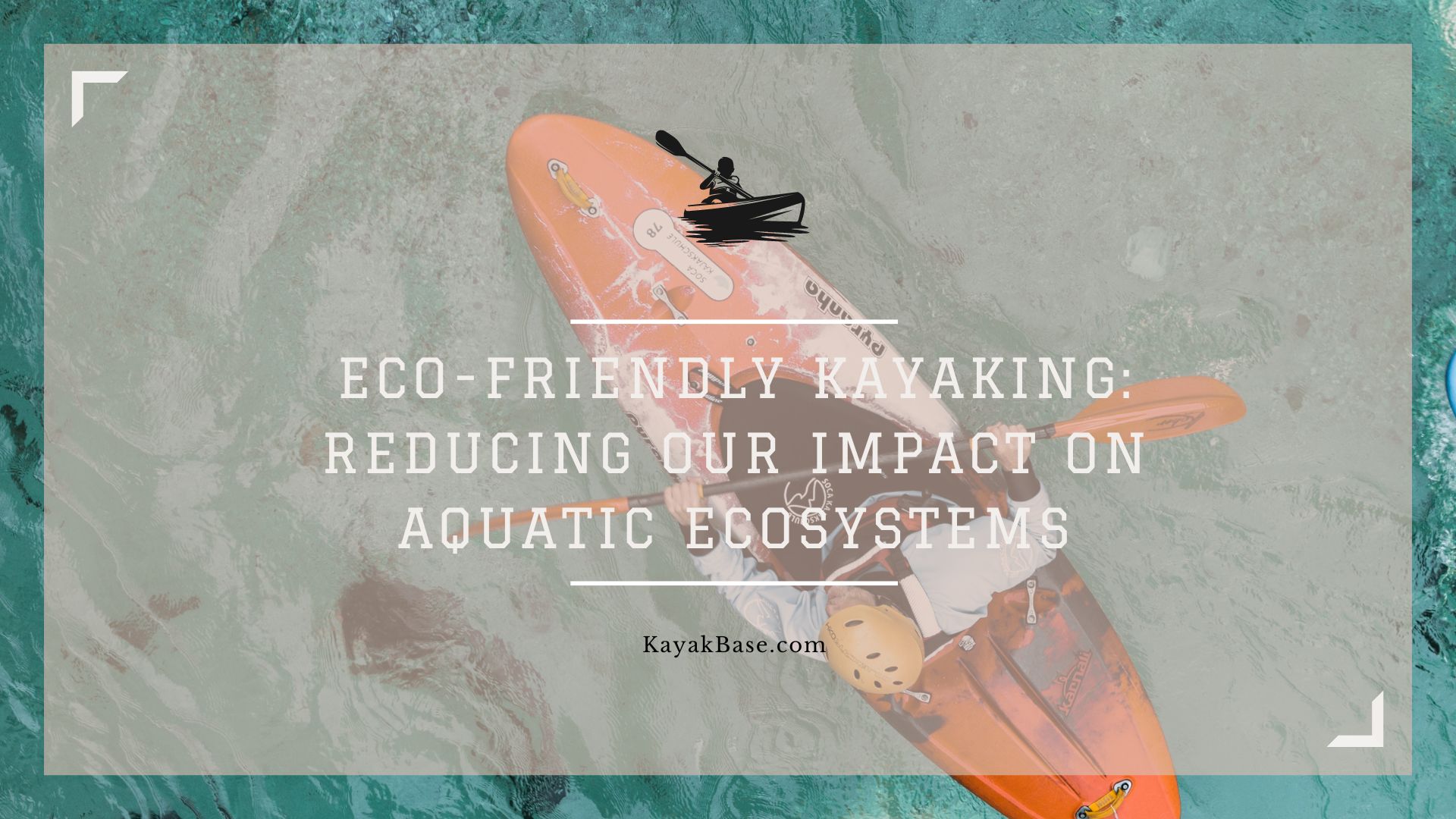Last Updated on June 8, 2023 by Afsar
As we continue to become more environmentally conscious, our outdoor activities are also evolving to align with our commitment to sustainability. One such sport that has a significant potential to be eco-friendly is kayaking. This water-based activity offers us a unique opportunity to interact with nature, but it is crucial that we do so responsibly. With a few mindful practices, we can ensure our kayaking adventures leave the least possible impact on aquatic ecosystems.
Eco-friendly Materials and Practices in Kayak Manufacturing
One way the kayaking industry is reducing its environmental impact is by utilizing more eco-friendly materials and manufacturing processes. Kayak manufacturers are increasingly turning to materials like recycled plastics and sustainably sourced woods to construct their vessels. Using recycled materials in the production process helps reduce waste and contributes to a circular economy. Furthermore, manufacturing practices are also changing, with many companies opting for energy-efficient processes, reducing carbon emissions and energy consumption.
Responsible Kayaking: The Leave No Trace Principles
Beyond using a sustainably made kayak, it is crucial to practice responsible kayaking, which starts with adhering to the “Leave No Trace” principles. These guidelines, initially established for land-based outdoor activities, have now been adapted to aquatic environments, and they stress the importance of respecting wildlife, minimizing waste, and leaving natural areas unaltered.
Plan Ahead and Prepare
“Plan ahead and prepare” refers to the steps you need to take before embarking on your kayaking journey. This includes understanding the rules and regulations pertaining to the area you’ll be visiting. Each region, state, and country may have its own specific guidelines regarding waterway access, allowable activities, and restrictions to protect local flora and fauna.
Some regions might also have particular concerns due to sensitive species or ecosystems. For instance, certain areas might be off-limits during particular times of the year due to wildlife breeding or migration patterns. Similarly, some areas may require permits or have limitations on the number of kayakers allowed per day to minimize human impact.
To gather this information, use resources like maps, guidebooks, or official websites. Local authorities, park rangers, or local outdoor recreation groups can also provide valuable insights into best practices for the region. Preparation will not only ensure you’re abiding by rules but also help protect the habitats you are enjoying.
Travel and Camp on Durable Surfaces
“Travel and camp on durable surfaces” is about minimizing the physical impact on the natural environment. In a kayaking context, this means sticking to established waterways and routes. By doing so, you’re less likely to disrupt sensitive habitats like marshes, nesting grounds, or areas of reeds and lilies that provide shelter and food to a range of species.
If you’re on a multi-day kayaking trip that involves camping, set up your camp on durable surfaces that can withstand the impact. These include established campsites, gravel, dry grasses, or snow. Avoid camping too close to lakes, rivers, or streams as this can lead to erosion and pollution of the waterways.
Dispose of Waste Properly
“Dispose of waste properly” is perhaps one of the most critical aspects of responsible outdoor activities. When kayaking, carry a trash bag with you and ensure you bring back all your waste – this includes food scraps, packaging, and human waste in some cases. Not only is it unsightly to leave trash behind, but it can also be harmful to wildlife that might ingest it or get tangled in it.
Never throw any waste into the water. Remember that many forms of waste can take years to decompose and may release harmful chemicals into the environment in the process. If bathroom facilities are not available and you need to relieve yourself, do so at least 200 feet away from any water source to prevent potential contamination. Use a portable travel toilet or pack out your waste if required.
It’s crucial to remember that “dispose of waste properly” also applies to what’s often termed ‘biodegradable’ waste, such as apple cores or banana peels. While these items may eventually break down, they are not native to the aquatic environments you’re exploring and can harm local wildlife or disrupt the natural food chain.
Leave What You Find
“Leave what you find” is a principle of respect for the natural environment. It means that everything in nature, no matter how small or seemingly insignificant, should be left exactly as you found it. This includes not disturbing wildlife or plants, picking flowers, moving rocks, or removing shells or other natural objects. There are a few reasons for this principle. First, removing natural objects can disrupt the ecosystem. Shells, for instance, can provide homes for small creatures or break down into sand. Rocks might provide shelter for insects or small animals. Second, the cumulative impact could be significant if every visitor to a location were to take a ‘souvenir’ from the site. Furthermore, disturbing wildlife can cause animal stress and potentially disrupt their normal behavior patterns. Feeding wildlife can be particularly harmful, as it can make them dependent on human food sources, often unsuitable for their dietary needs. It’s essential to observe wildlife from a respectful distance.
Minimize Campfire Impact
“Minimize campfire impact” is about reducing the potentially damaging effects of campfires on the environment. If you must build a fire during your kayaking adventure, use established fire rings, fire pans, or mound fires. These methods concentrate the heat and keep the fire contained, reducing its impact on the surrounding area.
Keep fires small and manageable. A smaller fire reduces the amount of wood you’ll need, lessening the impact on the local environment. Furthermore, smaller fires are easier to control and less likely to spread accidentally.
Remember, you should use fallen branches or twigs only for your fire, not breaking branches off living trees. Never cut down trees for firewood. It’s also important to fully extinguish the fire before leaving it unattended to prevent accidental wildfires.
Lastly, it is always important to abide by local regulations regarding fires. In some locations, fires might be prohibited altogether due to the risk of wildfires or to preserve the natural environment. In these cases, you might need to use a camping stove for cooking instead.
Both these principles – “leave what you find” and “minimize campfire impact” – help to ensure that our natural environments are preserved for future generations to enjoy and for the continued health of our ecosystems.
Reducing Invasive Species Transmission
Invasive species are a significant threat to aquatic ecosystems. These non-native species can spread through the transportation of water, mud, or critters that cling onto kayaks, paddles, and gear. To prevent this, kayakers should thoroughly clean and dry their equipment after each use, especially when moving between different bodies of water.
Education and Advocacy
Eco-friendly kayaking goes beyond individual practices. As members of the outdoor recreation community, kayakers can play a crucial role in education and advocacy. Share best practices with other paddlers, get involved with local conservation efforts, and support policies that protect our waterways.
Conclusion
Eco-friendly kayaking represents a meaningful step towards preserving the aquatic ecosystems we so cherish. As we paddle our way through rivers, lakes, and seas, it’s important to remember that we are visitors in these habitats. By choosing sustainable equipment, following the Leave No Trace principles, preventing the spread of invasive species, and advocating for conservation, we can ensure that these beautiful waterways remain for future generations to explore and enjoy.

Afsar is an avid kayak blogger born near the coast. He has a passion for kayaking and started as a child. He has paddled in various conditions and locations and promotes responsible kayaking. Afsar’s blog is widely read, and they are a respected voice in the kayaking community, offering valuable content on kayaking trips, gear, tips, and tricks. Afsar collaborates with other bloggers and brands and continues to inspire others through their writing and social media.

